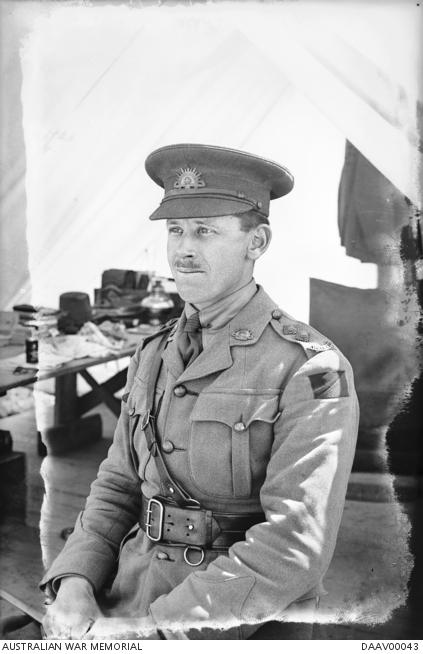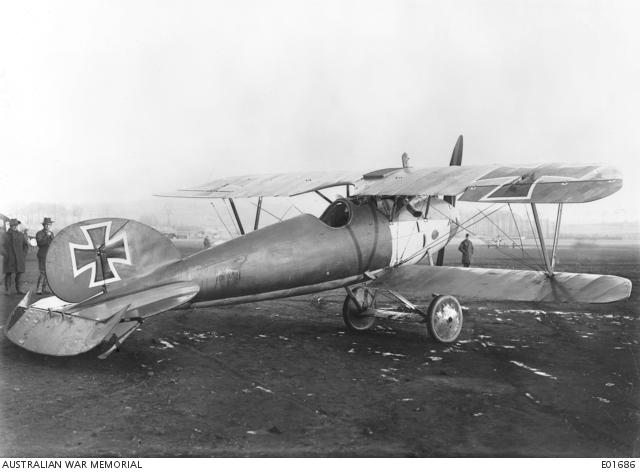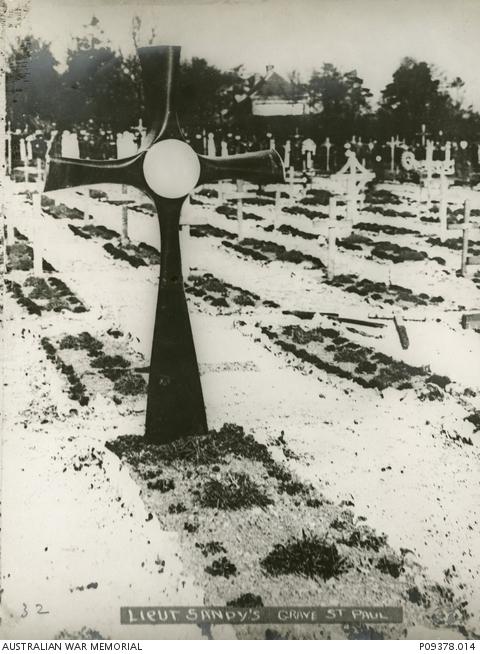Capturing the Albatros

Lieutenant James Lionel Montague Sandy of the Australian Flying Corps.
It was the first enemy aircraft to be brought down intact by the Australian Flying Corps (AFC) during the First World War, but the story behind the capture of the German Albatros fighter and what happened to the men who brought it down is a remarkable one.
Lieutenant James Sandy and Sergeant Henry Hughes climbed into their R.E.8 reconnaissance aircraft on 17 December 1917 and took to the skies over the Western Front near Armentières. The weather was bad and there were patches of snow on the ground, but the pair had a job to do.
“Sandy and Hughes were members of No. 3 Squadron AFC, which carried out photo-reconnaissance and artillery spotting sorties in support of the newly-formed Australian Corps in late 1917,” said Aaron Pegram, a senior historian at the Australian War Memorial.
“Equipped with the ungainly twin-seater reconnaissance aircraft, the Royal Aircraft Factory R.E.8 (or ‘Harry Tate’ as it was known to airmen and ground crews of the time), they performed a very important role in flying over no man’s land, observing the fall of artillery, making sure rounds were landing where they should be, and photographing the German positions so they could be used to create trench maps.

Jospeh Simpson's painting of Sandy and Hughes over the Western Front.
“This sort of work was exceptionally dangerous. The R.E.8 was a slower, less nimble aircraft than the single-seater fighters (or “scouts” as they were known at the time) and was not built for aerial combat. Its job was to fly over German lines, turn around and fly back the other way – and repeat the process until they had completed mapping or observing the corps front. This sort of work was not as romantic as the dawn patrols of the scout squadrons, who pursued German aircraft and engaged them in aerial combat, but they nevertheless played a crucial role in the air war during the First World War.
“Twin-seaters like the Harry Tate could take a fair beating – from anti-aircraft fire from the ground, and being jumped by whole squadrons of German scouts. The pilot had one forward-firing Vickers machine-gun, and the observer in the back was equipped with two ring-mounted Lewis guns to defend the aircraft from the rear. But the job of these airmen was to avoid getting into scraps with the Germans and to monitor what was happening on the ground.”
Sandy, 32, was one of No 3. Squadron’s more experienced airmen, while his observer, Hughes, who was four years younger, was making his first operational flight. The pair was flying over the battlefield, ranging an 8-inch howitzer for the 151 British Siege Battery, when they were attacked by six German Albatros scouts.

Portrait of Lieutenant James Lionel Montague Sandy, wearing the colour patch of the 1st Field Artillery. A company secretary from Burwood, NSW, Sandy enlisted in August 1914 and served on Gallipoli as one of the original members of the 1st Field Artillery. After becoming seriously ill, he returned to Australia and was discharged in August 1916. He re-enlisted in October the same year and joined the Australian Flying Corps (AFC).
They were heavily outnumbered, and the fight should have been over quickly. But watched by hundreds of men on the ground, Sandy and Hughes managed to defend themselves for several minutes. With Hughes manning a Lewis machine-gun, while Sandy controlled the forward-firing Vickers machine-gun, they brought down the German aircraft, forcing it to land in front of one of the 21st Battalion’s dugouts. Australian troops on the ground scrambled out of the dugout and the German pilot was captured.
Seeing that Sandy and Hughes were outnumbered and in trouble, another two R.E.8s from the squadron came to their aid. The two observation planes managed to cover each other and combine their defensive fire. As a third R.E.8 flew to join the firefight, the German formation broke off and flew back to their lines. One of the Australian pilots then flew close to Sandy and Hughes, and, seeing that their aircraft was cruising normally, assumed the pair was going to continue with their artillery work.
“All appeared to be well,” said Amanda New, an assistant curator at the Memorial, who presented a talk on the capture of the Albatros.
“However by 6 pm, the men still hadn’t returned to base. Despite 3 Squadron sending out numerous telephone messages, no trace of the men or their aircraft could be found. It wasn’t until 24 hours later that the mystery of their disappearance was solved.

A view of the German Albatros D5A scout aeroplane brought down by Australian airmen near Armentieres in France on 17 December 1917.
“A telegram was received from No. 12 Stationary Hospital at Saint Pol, stating that the bodies of Sandy and Hughes had been found in a crashed R.E.8 in a neighbouring field.
“In what must have been the last seconds of the fight, a bullet fired from behind the R.E.8 struck Hughes in the left lung and then passed on to strike Sandy in the base of the skull, killing them both instantly. The R.E.8, with its flight controls apparently in a neutral position and the throttle high, settled into a series of wide left-hand circles until the petrol ran out and the engine stopped.”
Without engine power, the R.E.8 came down in a steep glide and landed, unseen, about 80 km from the scene of the air battle. Those who examined the scene believe it would have taken about two hours for the R.E.8 to complete its remarkable flight. There were no further injuries to Sandy and Hughes. The two men were buried in the Saint Pol Communal Cemetery Extension.
While they were missing, Sandy had been recommended for the Military Cross, and Hughes for the Distinguished Conduct Medal – but the recommendations could not be posthumously approved.

The captured Albatros was displayed in Australia House in London before coming Australia.
The German Albatros that they had forced down was salvaged, and is on display at the Memorial as part of the Over the Front exhibition. The German pilot’s flying boots and a memorial plaque honouring Sandy are also on display. He was considered “one of the mainstays” of the squadron and his story was told in a Last Post Ceremony commemorating his life on the 100th anniversary of the R.E.8’s remarkable flight.
“Manned aerial flight was in its infancy during this time, however the technology and its application took tremendous leaps and bounds during the First World War. Soldiers of the Great War were still coming to terms with these relatively new machines and a completely revolutionary way of engaging the enemy from the air,” Pegram said.
“For a single bullet to enter a moving aircraft and kill both the pilot and the observer, Sandy and Hughes were incredibly unlucky. But that was the nature of the air war over the Western Front. Airmen of this period took enormous risks every time they took to the skies.”

The grave of Lieutenant James Lionel Montague Sandy of the AFC.